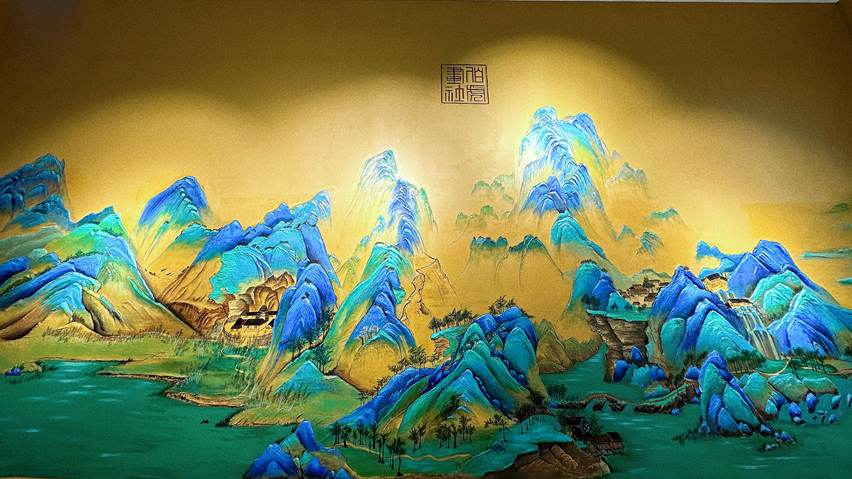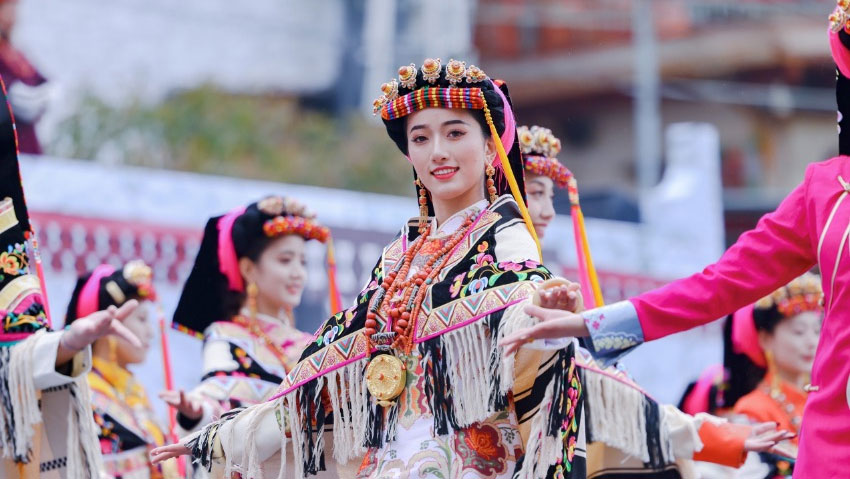Young entrepreneurs turn fine art into Gen-Z bestsellers
FUZHOU, Nov. 2 (Xinhua) -- Inside a quaint shop named "Ziyitang," a seasoned calligrapher with silver hair painstakingly yet elegantly inscribed the words "Time to get off work!" -- not the typical phrase you would expect to see on a piece of traditional calligraphy.
The store in Fuzhou, capital of east China's Fujian Province, is famous for its bespoke calligraphy works. These artistic writings, which contain both archaic greetings and trending hashtags, are inscribed on wooden bookmarks, folded fans and other handicrafts popular among Generation-Z customers.
Chen Yu, who owns the shop, hails from a family that specializes in the framing of paintings and calligraphy works. While the big-name artworks in her family often fetch thousands of dollars at auctions, items in "Ziyitang" are priced between 15 yuan (about 2 U.S. dollars) and several hundred.
"I hope to change the view that calligraphy and traditional paintings are mostly appreciated and purchased by the rich and the elderly," said the 29-year-old entrepreneur.
Chen's aspiration of appealing to young, budget-conscious customers is not unique in Sanfangqixiang (Three Lanes and Seven Alleys). In recent years, the historic neighborhood has seen a group of young entrepreneurs come together to transform ancient fine arts into creative cultural products.
Traditional fine arts have long struggled to increase their appeal to young consumers. When Chen started to take over the family business of calligraphy framing in 2015, she noticed a downtrend in the market for upscale artworks. In an effort to support the family's loyal customers -- a small circle of big-name artists -- she arranged exhibitions of their framed works to attract potential buyers.
"At those exhibitions, many young visitors told me they'd love to have such artworks in their homes but couldn't afford them," she said. "It occurred to me that traditional artworks have not lost their appeal to young Chinese, but are just beyond their financial reach."
With the support of her family, Chen in 2021 opened an outlet on the busy Nanhou Street of Sanfangqixiang. By streamlining procedures and enrolling retired artists who care more about having young fans than cashing a big cheque, Chen lowered the prices of the calligraphy works to that of a hotpot meal.
She now caters to a diverse range of customers, including students seeking a masterfully handwritten "Pass the exams," white collar workers decorating their offices with mounted calligraphy that reads "inner peace," and non-local workers who have ordered ink-and-wash paintings of their hometowns to hang in their rental apartments.
Bucking the trend of online shopping, Chen said the emotional value of traditional arts have brought many young shoppers to physical shops. "Watching a calligrapher write down their wishes harks back to the slow-paced old days. The historical neighborhood also amplifies the cultural aspect of the experience," she said.
Dubbed a "museum of the architecture of the Ming and Qing dynasties (1368-1911)," Sanfangqixiang is home to many historical personages, renowned literati and ancient craftsmanship. Since the 2000s, local authorities have repaired nearly 200 historic structures, many of which now operate as creative spaces such as themed museums, art workshops, and shops selling creative cultural products.
The coexistence of both old and new cultures has breathed new life into this ancient block, which has received more than 10 million annual visits since 2015. More than 60 percent of the 228 local businesses are now engaged in the cultural industry, according to the neighborhood's management.
"Ten years ago, shops in the area were mostly time-honored brands, but now both old and new cultural businesses thrive here," said Zheng Lingyi, owner of the beverage shop "Huanxichuo'o" in Sanfangqixiang.
The shop sells bubble tea, served in bottles decorated with poems about the local alleys, a design inspired by her experience working as an instructor at the block.
"Young visitors like to take photos of the bottle against the backdrop of the alley mentioned in the poem. It can also provide them with some cultural knowledge while they explore the neighborhood," Zheng said.
In the block's newly-opened center for the cultural and creative industry, masters of intangible cultural heritages also showcase their latest works, from tumbler toy-shaped incense holders to voice-activated paper-sculpture lamps, whose designs and price are friendly to young bargain hunters.
"We mix new designs with old artifacts to give our young customers a better understanding of the arts' history," said Jin Peng who runs the center.
Boosted by bestsellers such as calligraphy and ancient-style hairpins, the center registered a daily revenue of 30,000 yuan during the National Day holiday, Jin said.
For entrepreneurs like Jin and Chen, the young people's growing fascination with traditional fine arts promises a bright future for the sector.
"When I decided to open an outlet in Sanfangqixiang, my father said if we couldn't survive on such a busy street, then probably the skill is doomed to be lost to history," said Chen. "It's the Gen-Zers' love for traditional love that keep our business afloat. We wouldn't succeed if we did it 10 years earlier."
Photos
Related Stories
- Indonesian Gen Z stylist fascinated by ethnic cultures in China
- New outline aimed at greater Fujian-Taiwan connectivity, integration
- Farmers harvest razor clams in Fuzhou, SE China's Fujian
- 1,036th anniversary of Mazu's ascension to heaven marked in Fujian
- Mainland official highlights promoting connectivity, integrated development of Fujian, Taiwan
- China to set up cross-Strait integrated development demonstration zone
Copyright © 2023 People's Daily Online. All Rights Reserved.









